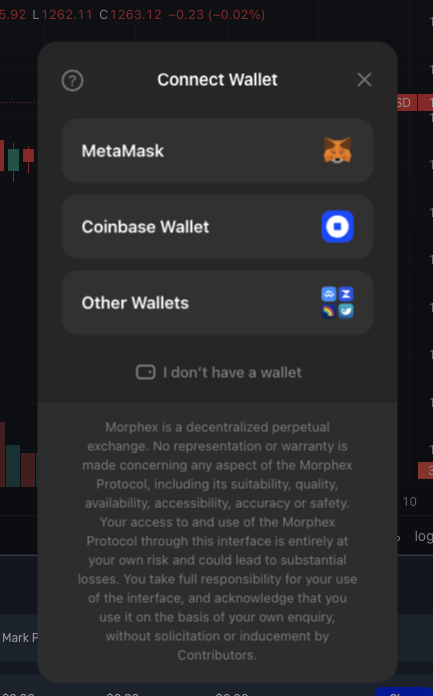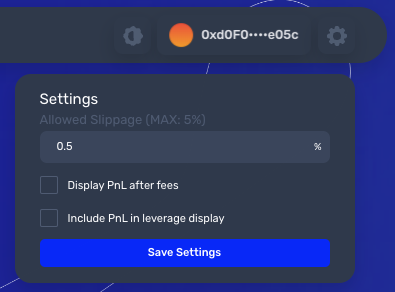Trading Guide

Wallet Connection and Initial Steps
Upon visiting the site, you will need to click Connect Wallet in order to establish connection with the dApp, which will then present you with various wallet options, as well as a basic explanation for new users about wallets (by clicking the question mark icon):

If this is your first time using Fantom, then you will need to add the network settings to your wallet of choice:
Network Name: Fantom Opera
RPC URL: https://ftm.sakurarpc.io (opens in a new tab)
ChainID: 250
Symbol: FTM
Block Explorer URL: https://ftmscan.com (opens in a new tab)
SakuraRPC (https://www.sakurarpc.io (opens in a new tab)) is a RPC meta-aggregator built by the trusted UniDex team (https://www.unidex.exchange (opens in a new tab)). Sakura will automatically select the lowest latency RPC node on Fantom for you, being especially valuable during periods of high congestion.
If you would prefer to use a more traditional RPC provider, then we would recommend visiting https://chainlist.xyz (opens in a new tab) and selecting the lowest latency Fantom RPC node.
For some more information on setting up common wallets for Fantom, please check this guide from the Fantom Foundation (opens in a new tab).
In order to begin trading, you will need to have FTM in your Fantom account to send transactions. Head on over to our Discord server and find the #faucet channel, where our bot will drip you some free FTM for gas (but make sure to first purchase some more FTM, so that you won’t run out of gas).
Swapping
Morphex supports both regular swaps and leveraged trading. In order to swap, click on the Swap tab on the Trade page, allowing you to swap various tokens with zero price impact.
For more information on leveraged trading, please read the sections below.
Opening a position
Click on Long or Short depending on which side you would like to open a leverage position on:

Long position
- Earns a profit if the token's price goes up
- Makes a loss if the token's price goes down
Short position
- Earns a profit if the token's price goes down
- Makes a loss if the token's price goes up
After selecting your position, input the amount you want to trade with and the desired leverage.
When you open or close a position, you'll pay a 0.1% fee on the size of the position. Additionally, you'll pay a Borrow Fee every hour that you hold a position. This fee is calculated based on the amount of assets you've borrowed and the total assets in the pool, and it's expressed as a percentage that varies based on utilization.
While there's no price impact on trade, there may be slippage due to price changes between the time you submit your trade and the time it's confirmed on the blockchain. Slippage is the difference between the expected and execution prices of the trade. You can customize your allowed slippage by clicking the Settings icon next to your address in the top right corner of the page.

Managing Positions
Once you’ve opened a trade, you can view it under the Positions list and manage it by clicking the ... button to add or remove collateral. This allows you to control your leverage and liquidation price.
A snapshot of the USD value of your collateral is taken when you open a position or add collateral. For example, if you have 1000 FTM as collateral and the price of FTM is $0.25, the value of your collateral would be $250. This value does not change even if the price of FTM fluctuates.
The profit or loss you make is based on the size of your position. Using our previous example, you have used $250 to buy $1250 worth of FTM (5x leverage long). If the price of FTM increases/decreases by 10%, you would have a profit/loss of roughly $125. If in a short position, then you would profit if the price of the asset decreases, while making a loss if the price increases.
The leverage of a position is calculated as (position size) / (position collateral). You can customize this by clicking the Settings icon next to your address to show (position size + PnL) / (position collateral).
Note that when adding collateral to a long position, there is a 0.3% swap fee for converting the asset to its USD value (to prevent deposits from being used as a zero fee swap). This fee does not apply to short positions or when withdrawing collateral from long/short positions.
Closing a Position
You can close a position partially or completely by clicking on the "Close" button.
For long positions, profits are paid in the asset you are longing, e.g. if you long FTM you would receive your profits in FTM. For short positions, profits will be paid in the same stablecoin used when opening the position.
Order Types
Market Orders
A market order is a type of trade that is executed at the current oracle price, without incurring any spread for assets like FTM. However, when trading long tail assets (when they are added), such as LINK for example, there may be a small spread added. Market orders are the default option for all traders, and are ideal for those who wish to enter the market immediately.
Limit Orders
A limit order is a type of trade that is executed only when the market price reaches a specific level. For a long position, this means that the order is executed when the ask price is less than or equal to a specified price. For a short position, limit orders are executed when the bid price is greater than or equal to a specified price. These orders are useful for traders who want to enter a position, but only when a certain target price is reached. The fee for these orders will be more than a market order to pay for the keeper costs.
Stop-loss/Take-profit
In addition to limit orders, there are also stop-loss and take-profit orders. A stop-loss order is a type of limit order that automatically closes a position when it reaches a certain amount of capital loss. A take-profit order, on the other hand, is a limit order that closes a position when it reaches a certain amount of capital gain. These types of orders are typically placed by traders who already have a position open and want to protect their profits or limit their losses.
To set a stop-loss or take-profit order, click on the "Close" button on your open position and select the "Trigger" tab. These orders will appear in your position's row and under the "Orders" tab. You can edit the trigger price of these orders if needed. If you close a position manually, the associated trigger orders will remain open. You will need to cancel them manually as well if you do not want them to be active when opening future positions.
It’s important to note that orders are not guaranteed to execute and trigger orders are market orders that may not execute at the trigger price. Possible reasons for an order not executing include, but are not limited to:
- the mark price (an aggregate of exchange prices) not reaching the specified price
- the specified price being reached but not for long enough to execute
- no keeper picking up the order for execution.
Liquidations
Liquidations happen when a trader has insufficient funds to keep a leveraged trade open.
The liquidation price is the price at which (collateral - losses - borrow fee) is less than 1% of your position's size. If the token's price reaches this point, your position will be automatically closed.
The liquidation price can change over time due to the borrow fee, especially if you use a higher leverage and keep the position open for longer periods of time.
Always keep in mind the current liquidation price. If there is any collateral left after losses and fees are subtracted, that amount will be returned to your account.
Pricing
Trades on Morphex do not affect the price, so you can make large trades at the mark price. During times of high volatility, there may be a spread between the Chainlink price and the median price of reference exchanges.
The mark prices are displayed next to the market name. If you have a long position, it will be opened at the higher price and closed at the lower price. If you have a short position, it will be opened at the lower price and closed at the higher price.
Potential Slippage
Our decentralized perpetual trading platform operates without the traditional design of an orderbook or AMM, allowing for trades to be settled at the oracle price without any impact on the price. However, it is important to note that there may be some slippage, which is the difference between the intended and actual execution price, due to price movements between the submission and confirmation of a trade on the blockchain. To mitigate this, traders can set a slippage tolerance, with a default of 0.3%, which can be adjusted by going to Settings under the dropdown icon next to your address in the top right corner of the page. Keep in mind, if the slippage tolerance is set too low, e.g. below 0.5%, there is a risk of failed orders during periods of high market volatility.
Fees
Spot Trading
Spot trading fees will vary depending on the assets being swapped. Low fees will be used to incentivize trades that cause productive assets to be deposited and unproductive assets to be withdrawn. In contrast, there will be a high fee on trades that cause unproductive assets to be deposited and productive assets to be withdrawn. This will move the allocation of assets across liquidity pools to the optimal levels.
- Base spot fee for volatile assets: 0.2%
- Base spot fee for stable assets: 0.01%
Leveraged Trading
- The cost to open or close a leveraged position is 0.1% of the position size.
- The collateral for long positions is the token being longed, and the collateral for short positions is a supported stablecoin (e.g. USDC, USDT, DAI). If a swap is needed when opening or closing a position, the regular swap fee (0.2% to 0.8% of the collateral size) will apply. This is to prevent deposits from being used as a zero fee swap. Withdrawing of collateral from longs and shorts do not have this fee.
- Traders will be charged a borrowing fee on the total value of their position. The fee rate will increase as the utilization of a specific asset in the liquidity pool increases. This is to deter the utilization of any given asset from reaching 100% and to maintain liquidity in the pool. The borrowing fees will be deducted from the user's margin when their position is settled. The fee rate will vary continually based on utilization, calculated as
(assets borrowed) / (total assets in the pool) * 0.01%. - There is also an execution fee detailed below which is used to pay for the blockchain network costs.
Execution Fee
There are two transactions involved in opening / closing / editing a position:
- User sends the first transaction that requests to open, close, deposit collateral or withdraw collateral
- Keepers observe the blockchain for these requests then execute them
The execution fee is detailed when confirming the creation of a position.